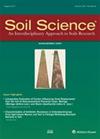摩洛哥南部摩洛哥坚果树空间分布对土壤性质的影响
4区 农林科学
Q2 Agricultural and Biological Sciences
引用次数: 5
摘要
摘要摩洛哥南部特有的摩洛哥坚果树(Argania spinosa)种群由于过度砍伐、非法采伐木柴和集约化农业的扩张而高度退化。孤立树木之间的光秃秃的面积由于再生有限而增加;然而,尚不清楚树木是否会影响树间地区的土壤。假设,树间土壤参数的空间差异应该是由于凋落物或土壤颗粒(通过径流和侵蚀或风漂)从树冠覆盖区转移到树间区。在距离树木50 m处,沿着树木滴流线(树内和树外)和两棵树之间的四个方向(上、下坡和平行于斜坡的两个方向),从树干周围采集了385个土壤样本。对土壤水分、pH、电导率、渗透稳定性、全氮含量(TN)、土壤有机碳(SOC)含量和碳氮比进行了分析。在树木滴液线附近、树区内外共进行了74次张力盘式渗透仪实验,测量了非饱和导水性。研究发现,树木对其周围树间面积的影响有限,从树干(4.4% SOC和0.3% TN)到树滴线(2.0% SOC和0.2% TN),有机碳和全氮含量显著下降。然而,疏水线附近的树间面积(有机碳含量为1.3%,全氮含量为0.2%)与两棵树间的树间面积(有机碳含量为1.0%,全氮含量为0.1%)差异显著,但影响不大。受风漂和坡面冲刷的影响,东部和下坡方向的空间格局变化趋势明显。由于正午遮阳,土壤含水量在北方最高;影响扩展到树间区域。非饱和导电性在树内、树外、树滴线附近也有显著差异。这是在不同土地用途(森林和农业)、坡度或树木密度下的情况。虽然对树间面积的影响有限,但树木周围的空间格局表明,应针对土壤含水量或TN或SOC含量较高的北部或东部方向的树木遮蔽物周围进行再造林,以确保幼苗存活,并采取措施防止过度放牧。本文章由计算机程序翻译,如有差异,请以英文原文为准。
Spatial distribution of argan tree influence on soil properties in southern Morocco
Abstract. The endemic argan tree (Argania spinosa) populations in southern Morocco are highly degraded due to overbrowsing, illegal firewood extraction and the expansion of intensive agriculture. Bare areas between the isolated trees increase due to limited regrowth; however, it is unknown if the trees influence the soil of the intertree areas. Hypothetically, spatial differences in soil parameters of the intertree area should result from the translocation of litter or soil particles (by runoff and erosion or wind drift) from canopy-covered areas to the intertree areas. In total, 385 soil samples were taken around the tree from the trunk along the tree drip line (within and outside the tree area) and the intertree area between two trees in four directions (upslope, downslope and in both directions parallel to the slope) up to 50 m distance from the tree. They were analysed for gravimetric soil water content, pH, electrical conductivity, percolation stability, total nitrogen content (TN), content of soil organic carbon (SOC) and C/N ratio. A total of 74 tension disc infiltrometer experiments were performed near the tree drip line, within and outside the tree area, to measure the unsaturated hydraulic conductivity. We found that the tree influence on its surrounding intertree area is limited, with, e.g., SOC and TN content decreasing significantly from tree trunk (4.4 % SOC and 0.3 % TN) to tree drip line (2.0 % SOC and 0.2 % TN). However, intertree areas near the tree drip line (1.3 % SOC and 0.2 % TN) differed significantly from intertree areas between two trees (1.0 % SOC and 0.1 % TN) yet only with a small effect. Trends for spatial patterns could be found in eastern and downslope directions due to wind drift and slope wash. Soil water content was highest in the north due to shade from the midday sun; the influence extended to the intertree areas. The unsaturated hydraulic conductivity also showed significant differences between areas within and outside the tree area near the tree drip line. This was the case on sites under different land usages (silvopastoral and agricultural), slope gradients or tree densities. Although only limited influence of the tree on its intertree area was found, the spatial pattern around the tree suggests that reforestation measures should
be aimed around tree shelters in northern or eastern directions with higher soil water content or TN or SOC content to ensure seedling survival, along with measures to prevent overgrazing.
求助全文
通过发布文献求助,成功后即可免费获取论文全文。
去求助
来源期刊

Soil Science
农林科学-土壤科学
CiteScore
2.70
自引率
0.00%
发文量
0
审稿时长
4.4 months
期刊介绍:
Cessation.Soil Science satisfies the professional needs of all scientists and laboratory personnel involved in soil and plant research by publishing primary research reports and critical reviews of basic and applied soil science, especially as it relates to soil and plant studies and general environmental soil science.
Each month, Soil Science presents authoritative research articles from an impressive array of discipline: soil chemistry and biochemistry, physics, fertility and nutrition, soil genesis and morphology, soil microbiology and mineralogy. Of immediate relevance to soil scientists-both industrial and academic-this unique publication also has long-range value for agronomists and environmental scientists.
 求助内容:
求助内容: 应助结果提醒方式:
应助结果提醒方式:


